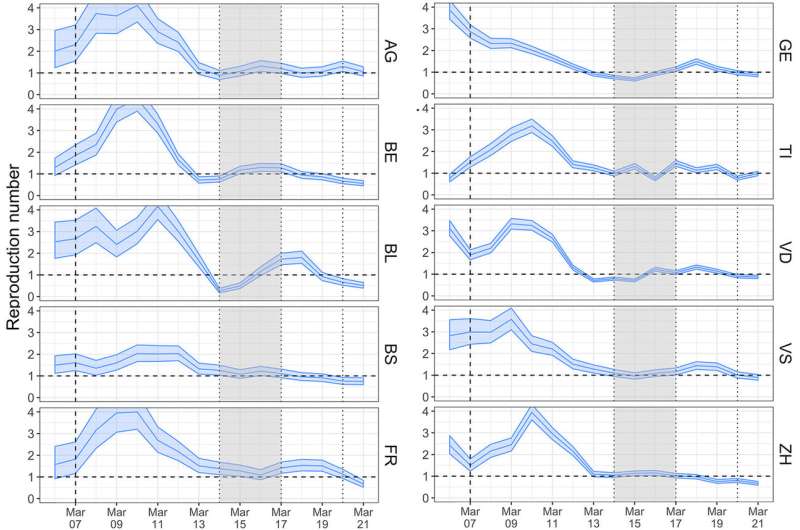Lockdown measures are having an impact in spread of COVID-19

The "lockdown light" decreed by the Swiss Federal Council has led to each person infected with Sars-CoV-2 going on to infect only one person on average instead of two or three prior to the lockdown, as calculations by a team from ETH Zurich have shown. This means the situation is stable, but the epidemic has yet to be contained.
The Swiss Federal Council's measures to contain the pandemic are having an impact throughout Switzerland: before the decision to close schools on 13 March and the declaration on 16 March of an "extraordinary situation" with further social distancing measures, each person infected with the novel coronavirus went on to infect two to three others on average. As a result, cases of illness were increasing exponentially. Since the measures have been in place, each person has infected only one other person on average. This is the result of calculations conducted by a team led by Tanja Stadler, a professor in the Department of Biosystems Science and Engineering at ETH Zurich in Basel.
"The situation has been stable since the measures were taken. We have definitely slowed down the spread considerably," Stadler says. "People are still contracting the virus on a daily basis, but the increase is now linear instead of exponential." The analysis does not show the impact of each specific control measure on stabilizing the situation.

Uniform picture across Switzerland
The number of people an infected person goes on to infect is known in epidemiology as the reproduction number. The ETH researchers calculated this number using data on confirmed new Sars-CoV-2 infections that the cantons publish daily. In addition to a nationwide evaluation, the scientists also evaluated the data at cantonal level for ten of the eleven cantons most severely affected by the epidemic. The picture is the same everywhere: when measures were introduced, the reproduction number dropped to one.
Jérémie Sciré, a doctoral student in Stadler's group and lead author of the study, points out that the data used in these analyses could contain errors. This is because test kits and cotton swabs were scarce in Switzerland and it cannot be ruled out that during the course of the epidemic, individual screening centers may at times have tested only at-risk patients while at other times they may have tested other people as well. A change in test practice of this nature would bias the calculation.

Results are meaningful
For this reason, the scientists calculated the reproduction number in two other ways that are less prone to error. For the nationwide evaluation, they used reported COVID-19 related deaths; for evaluating the cantons of Basel-Stadt and Basel-Landschaft, they used the number of hospital admissions. "In the current situation, in which all coronavirus patients in the Basel area can be admitted to hospital, admissions are a reliable indicator as no cases go unrecorded," Stadler says. Reported deaths is also regarded as a reliable indicator.
A comparison of the different calculation methods showed that they all yield similar results. "That gives us confidence in our calculations based on new infections," Stadler says. She and her colleagues, based at ETH Zurich as well as the University of Basel and the University Hospital Basel, among others, submitted their study for publication on the medRxiv preprint server. It should appear in a few days without going through the scientific review process.

Too early to relax the measures
Is the data encouraging enough to consider relaxing social distancing measures? "It's too early for that," Stadler says. The fact that the situation is currently stable is certainly positive, for example for hospitals and their capacity planning: as long as the situation remains like this, hospitals know that they will need as much capacity for new admissions in the future as they do now.
However, this does not mean the epidemic is contained. "If we lift those measures anytime soon, there's no doubt that the virus will immediately begin spreading exponentially again," Stadler says. Only once the peak of the epidemic is definitely far behind us can the current measures be lifted and replaced. A reproductive number well below one would be an indication that this point has been reached.
An app for contact tracing holds promise
That is the point in time at which the current drastic measures could conceivably be replaced with an effective system for identifying people who have had contact with an infected person—known as contact tracing—and, based on this, for ensuring the isolation not just of people with the infection but also of their contacts who test positive for the virus. "For this to work, the tracing process must be very fast. One way to achieve that would be with an app featuring SMS alerts, which is now being discussed," Stadler says. However, the promise of such tracing and isolation arrangements relies on the number of patients being small. "If the previous measures were replaced by contact tracing and isolation today, I fear that many of us would receive a text message within a few days telling us we had recently been close to an infected person."
On 20 March, the Swiss Federal Council tightened the measures further and decreed that people may meet in groups of no more than five, provided that they remain an appropriate distance apart. It is still too early to tell whether this tightening is sufficient to contain the epidemic. "That's something we should start seeing in the next few days," Stadler says. She and her colleagues will continue their evaluation on an ongoing basis.
More information: For more information, see bsse.ethz.ch/cevo/research/sars-cov-2.html




















